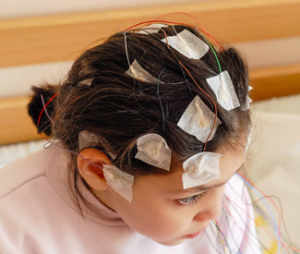Tics are involuntary, spasm-like movements of particular muscles in the body. The particular muscles affected differ from patient to patient and can be located throughout the body, including in the throat, face, airways, eyes, and limbs.
Tics occur more frequently in the upper portion of the body but, again, can affect multiple parts of the body that contain muscle tissue.
Here’s what you should know about tics, various tic disorders, and how neurologists diagnose and treat them in patients.
Common Examples of Tics
Tics take a variety of forms, but the most common examples of tics include:
- twitch
- shrug
- blink
- sniff
- snort
- repetitive grimace
- click of the nose or throat
Who Is Affected Most By Tics?
Tics most often affect children between the ages of 5 and 12. By gender, tics affect males 3 times more than females.
Tics frequently appear during times of stress or tension, and may disappear upon cessation of the stressor. Intentional strategies to create distractions may reduce or eliminate the occurrence of the tic temporarily.
Individuals affected by either obsessive-compulsive disorder (OCD) or attention deficit/hyperactivity disorder (ADHD) are significantly more likely than the general population to develop tics.
Tics and tic disorders are distinct from other neurological conditions that trigger involuntary movements like spasms, cramps, epilepsy, Huntington’s disease, tremors, dystonia, etc.
Understanding the Different Types of Tics and Tic Disorders
Tics can be broken down into two types of tics: motor and vocal.
- Motor tics are short-lasting movements
- Vocal tics are uttered sounds
Both may occur suddenly during what is otherwise classified as normal behavior.
Simple vs Complex Tics
Tics may be further classified as either simple or complex. The following describes these two classifications:
Simple tics have a sudden onset, don’t last long, and affect only a few muscle groups. Examples of simple tics include:
- Motor: eye blinking, nose twitching, head jerking, shoulder shrugging, and facial grimacing.
- Vocal: throat clearing, yelping, and other noises, sniffing and tongue clicking.
Complex tics are coordinated movements across multiple muscle groups. Complex tic examples include:
- Motor: jumping, touching other people or things, smelling, twirling about, and only rarely, self-injurious
- Actions including hitting or biting oneself; usually a series of movements performed in the same order
- Vocal: uttering words or phrases out of context and coprolalia (vocalizing socially unacceptable words).
Transient Tic Disorder vs Chronic motor or vocal tic disorder
Let’s break down the difference between transient and chronic motor or vocal tic disorder.
- Transient tic disorder. This type of tic disorder usually impacts minors. To meet the criteria, there must be at least two tics that last no longer than one year but endure for at least a month.
- Chronic motor or vocal tic disorder. Chronic Tic Disorder is rarer than transient tic disorder and lasts more than a year.
Tourette’s Syndrome
Tourette’s syndrome is the most serious form of tic disorder and involves both vocal and motor tics. About 140,000 American children are currently affected. Tourette’s syndrome symptoms generally improve over time as the patient ages, especially with effective interventions.
How Do Neurologists Diagnose Tic Disorders?
Neurologists use the following four characteristics to identify and diagnose tic disorders: the age when tics began, duration of the tics, the severity of the tics, and whether tics are motor or vocal or both.
Gilles de la Tourette syndrome, commonly known as Tourette syndrome or TS, is a neurological disorder that becomes evident in early childhood or adolescence before the age of 18 years.
Tourette syndrome is defined by multiple motor and vocal tics that last more than one year. The first symptoms usually are involuntary movements, tics, of the face, arms, limbs, or trunk. These tics are frequent, repetitive, and rapid. However, the most common first symptom is a facial tic (eye blink, nose twitch, or grimace), and is later replaced by or added to by other tics of the neck, trunk, and limbs.
How Do Neurologists Treat Tic Disorders?
The treatment for tic disorders depends on the severity of the condition. In many instances, no treatment is needed and the tics will resolve on their own. In other cases, doctors may prescribe behavioral therapy, medication, or a combination of the two.
Various forms of therapeutic interventions may result in relief or partial or full remission of symptoms over time. Examples include:
- Behavioral therapy helps people learn to manage their tic symptoms and reduce the tic frequency.
- Relaxation techniques. Because of the strong association between tic symptoms and stress and tension, doctors might prescribe visual imagery of calming “safe spaces,” progressive muscle relaxation, and deep breathing, techniques.
- Comprehensive Behavioral Intervention for Tics (CBIT). CBIT is a special CDC-recommended behavioral therapy modality that teaches patients to recognize what behaviors trigger CBIT and how to adapt their behaviors to limit or reduce their symptoms.
- Biofeedback. Biofeedback is the practice of gaining greater awareness of an individual’s physiological functions and, in turn, fostering increased voluntary influence. Although the efficacy of biofeedback therapy for treating tic disorders is somewhat controversial, “some evidence exists that neurofeedback (NFB) training aimed at enhancing SMR amplitude is effective for reducing tics.”
Medications to treat tics are typically used to reduce tic frequency and enhance a patient’s daily life. However, medication alone usually does not result in the complete remission of tic symptoms. Commonly prescribed medications to treat tics include:
- Clonidine
- Pimozide
- Haloperidol
- Fluphenazine
- Clonazepam
It’s important to keep in mind that many such medications – especially benzodiazepines like clonazepam – carry risks of side effects and physical dependency, so clinicians and patients must weigh the benefits with the potential long-term downsides of taking these drugs to treat tics.




